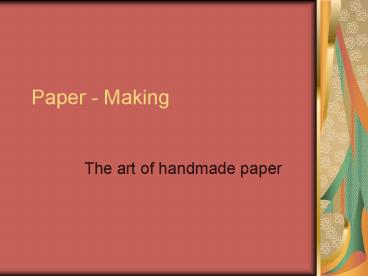Paper Making - PowerPoint PPT Presentation
1 / 31
Title:
Paper Making
Description:
The strips were then layered, pounded together and smoothed to make a flat, uniform sheet. ... mixed them with water, and pounded them with a wooden tool. ... – PowerPoint PPT presentation
Number of Views:130
Avg rating:3.0/5.0
Title: Paper Making
1
Paper - Making
- The art of handmade paper
2
Example of artistic handmade paper
3
The History of Paper
- Written communication has been the center of
civilization for centuries. Most of our important
records are on paper. Although writing has been
around for a long time, paper hasn't. - In fact, putting thoughts down in written form
wasn't always easy or practical. Early people
discovered that they could make simple drawings
on the walls of caves, which was a great place
for recording thoughts, but wasn't portable. - Imagine spending hours scratching a message into
a heavy clay tablet and then having to transport
it. That's exactly what the Sumerians did around
4000 B.C. Although this form of written
communication was now portable, it still wasn't
practical because of its weight.
4
Early Greek Paper
5
History continued
- For centuries, people tried to discover better
surfaces on which to record their thoughts.
Almost everything imaginable was tried. Wood,
stone, ceramics, cloth, bark, metal, silk,
bamboo, and tree leaves were all used as a
writing surface at one time or another. - The word "paper" is derived from the word
"papyrus," which was a plant found in Egypt along
the lower Nile River. About 5,000 years ago,
Egyptians created "sheets" of papyrus by
harvesting, peeling and slicing the plant into
strips. The strips were then layered, pounded
together and smoothed to make a flat, uniform
sheet.
6
History continued
- No major changes in writing materials were to
come for about 3,000 years. The person credited
with inventing paper is a Chinese man named Ts'ai
Lun. He took the inner bark of a mulberry tree
and bamboo fibers, mixed them with water, and
pounded them with a wooden tool. He then poured
this mixture onto a flat piece of coarsely woven
cloth and let the water drain through, leaving
only the fibers on the cloth. Once dry, Ts'ai Lun
discovered that he had created a quality writing
surface that was relatively easy to make and
lightweight. This knowledge of papermaking was
used in China before word was passed along to
Korea, Samarkand, Baghdad, and Damascus.
7
History continued
- By the 10th century, Arabians were substituting
linen fibers for wood and bamboo, creating a
finer sheet of paper. Although paper was of
fairly high quality now, the only way to
reproduce written work was by hand, a painstaking
process.
8
History continued
- By the 12th century, papermaking reached Europe.
In 1448, Johannes Gutenberg, a German, was
credited with inventing the printing press. (It
is believed that moveable type was actually
invented hundreds of years earlier in Asia.)
Books and other important documents could now be
reproduced quickly. This method of printing in
large quantities led to a rapid increase in the
demand for paper
9
Paper today
- For generations people have taken for granted how
paper was created from trees. - Now, paper is often recycled and made into new
paper to help preserve our natural resources.
10
Artistic expression through paper
11
(No Transcript)
12
(No Transcript)
13
(No Transcript)
14
(No Transcript)
15
(No Transcript)
16
Making your own paper
- How do artists create handmade paper? It is an
easy, inexpensive process that you could do at
home! - Be sure to ask mom or dad first!
- You will need a few basic supplies
- A blender, paper to be recycled (even paper
towels), water, a large basin or tub, a screen,
extra newspapers or towels, sponges and plenty of
space to dry your creation!
17
Step one
- Tear up pieces of the paper into a blender filled
3/4 of the way with water. With the lid on the
blender, blend the paper until it is a fine pulp
18
Step two
- Place your pulp into a large basin filled with
more water. The mixture should be very soupy.
19
Step three
- Run your screen under the pulp and pull up. This
is called pulling the pulp.
20
Step four
- Turn the screen over onto a stack of newspapers
or towels. Keep the screen in place while
sponging out the extra water. This is called
couching.
21
Step five
- Now lift the screen and voila you have a sheet
of paper. Allow to dry and you can write, paint
or draw on your new paper.
22
There are endless possibilities for papermaking.
- We will be casting our paper over plastic bowls,
which will create decorative paper bowls.
23
Other artistic possibilities
24
(No Transcript)
25
(No Transcript)
26
(No Transcript)
27
(No Transcript)
28
(No Transcript)
29
(No Transcript)
30
(No Transcript)
31
Now its your turn!!
- Some vocabulary to keep in mind
- papyrus
- pulp
- pulling
- couching
- decorative
- Essential question What is the purpose of your
work?































